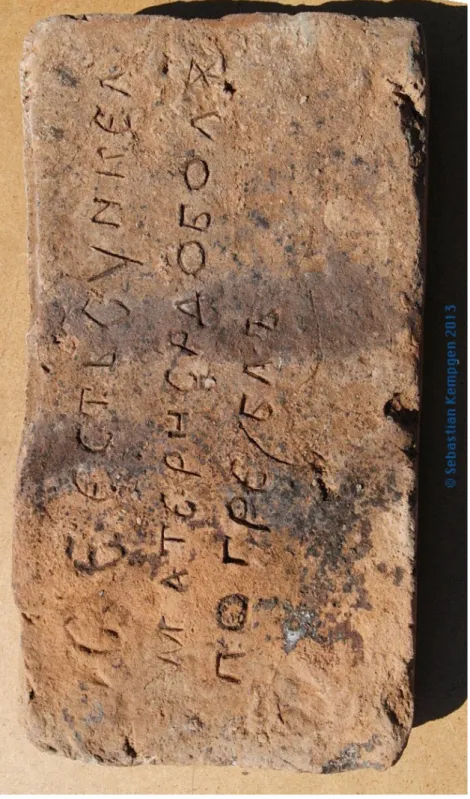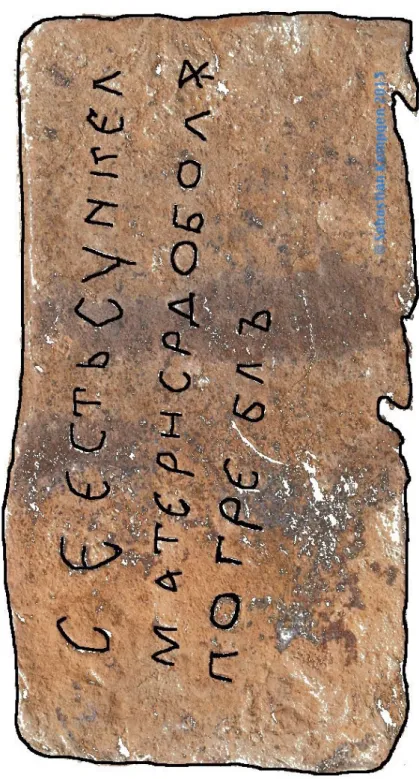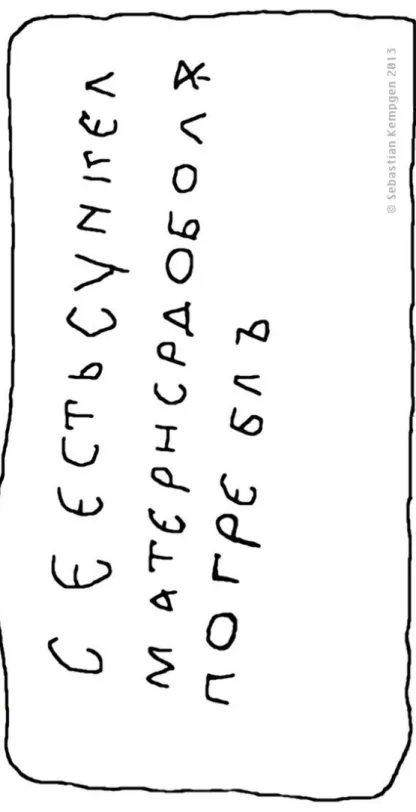Sebastian Kempgen
THE “SYNKEL” INSCRIPTION FROM VELIKI PRESLAV – A NEW READING
In September 2007, Bulgarian newspapers widely reported that prof. Kazimir Popkonstantinov, a well-known archeologist from St. Cyril and St. Methodius University of Veliko Tarnovo, had found “a thrilling inscription” (Novinite.com 2007, Sept. 19; Journey.bg Sept 21, 2007) in Veliki Preslav, 55 years after the now-famous Mostič inscription was discovered in the same monastery.1 The inscription was found in a grave or burial chamber near the main entrance to the monastery’s church, a most prominent place, and indicated that a synkel (the right hand to the bishop) had buried his mother there. The location gave rise to the hypothesis that the monastery wasn’t actually founded by Mostič, as previ- ously thought (cf. “Манастирът на Мостич”, “Mostič’s monastery”), but ra- ther by Georgi the Bulgarian synkellos, known from other archeological find- ings (seals).
Along with many other participants of the Preslavska knižovna škola 10 con- ference, which was held in Varna at that time, the author visited the archeologi- cal site on Sept. 23, 2007, that is, literally days after the discovery of the in- scription. During the visit, Kazimir Popkonstantinov allowed his guests a peek at the clay slab with the inscription on it and also to take photographs for their personal use, and demonstrated how he lifted the slab from the burial chamber.
The inscription has now (Nov. 2013) been published (along with other findings from the excavations), see Popkonstantinov, Kostova (2013). The article con- tains maps of the area, indicating the various burials, a photograph of the Synkel inscription, and comments upon the text itself.
In this paper, we will offer our own reading of the inscription, written ini- tially months before the publication of the aforementioned article (May 2013). It was sent to K. Popkonstantinov and R. Kostova that same month, with an ex- change of emails following, but for certain requirements of Bulgarian laws, its publication had to be upheld until the article by the archaeologists in charge of the Preslav site had been published. It is astonishing to note that their article
1 Kazimir Popkonstantinov himself names Rosina Kostova, now head of the excavations at Veliki Preslav, as the person finding the inscription along with him.
now interprets the inscription similar to our reading and thus is in stark contrast to all quotes published before. The author is under the impression that the sec- tion devoted to the Synkel inscription in Popkonstantinov, Kostova (2013) un- derwent some last-minute changes after having read his manuscript, without properly referring to it in the publication. Therefore, our paper will continue to refer to the publicly available interpretations of the inscription by K. Popkon- stantinov before he learned of our interpretation, and we will continue to claim authorship for the new, correct reading. In our article, we will also present our own photograph and drawing of the inscription.2
Without segmenting the text into words, the inscription reads as follows:
С Є Є С Т Ь С Ѵ Н К Є Л М А Т Є Р И С Р Д О Б О Л Ѫ П О Г Р Є Б Л Ъ
Various newspaper articles cite K. Popkonstantinov uniformly with the follow- ing translations of the Old Bulgarian inscription:
“Това е синкелът, който с болка на сърце погреба своята майка”
(Vaseeva 2007) – “Синкела погреба своята майка с болка на сърце”
(Bojanova 2009) – “Това е синкелът (който) погреба своята майка с голя- мо прискърбие, мъка” (Kacarska 2010) [≈ The synkellos has buried his mother with (great) pain in his heart]
One of these newspaper article (Bojanova 2009) comments upon the duties of a
‘synkel’, adding:
“Синкелът е бил дясната ръка на патриарха, тоест това е неговият секре- тар. Открили сме девет печата на този монах Георги и няма спор за лич- ността му. Нашите разсъждения ни водят към тезата, че вероятно става дума за фамилен манастир от X век и че погребаните в него са роднини на синкела”, обяснява проф. Казимир Попконстантинов. Антропологът проф. Йордан Йорданов е изследвал намерените кости и е доказал, че става дума за 25-30-годишна жена, която е напълно възможно да е майката на монаха Георги, защото това е била възрастта, която по онова
2 I wish to thank Kazimir Popkonstantinov and Rosina Kostova for their kind permission to publish my photograph (part of a small series), now that their publication is available, and especially Antoaneta Granberg, University of Gothenburg, for commenting on a first draft of this paper.
време се е смятала за преклонна.”3 [“The synkellos was the right hand of the patriarch, i.e. his secretary. We have discovered nine seals of this monk Georgi, and there can be no doubt as to his person. Our thinking leads us to the hypothesis that we can probably talk about a family monastery from the 10th century and that those who were buried in it were relatives of the syn- kel”, explains prof. Kazimir Popkonstantinov. The anthropologist prof. Jor- dan Jordanov has examined the bones and has shown that one can think about a 25 to 30 year old woman, who could be considered to be the mother of monk Georgi, because that was an age which in those times already counted as old.]
For the basic part, the inscription is clear linguistically: СЄ ЄСТЬ СѴНКЄЛ … ПОГРЄБЛЪ “Here, Synkel has buried…/It is Synkel who has buried…”. But who did he bury? Until now, the middle line seems to have been segmented into МАТЄРИ СРДОБОЛѪ i.e. “he buried his mother (under certain circumstanc- es)”. The word СРДОБОЛѪ seems to have been understood as a fem. noun of the so-called i-stems, used in the instr. sg. (like тварь – тварьѭ, кость – костьѭ etc.), meaning “with pain in one’s heart”.
However, this reading raises several grammatical questions at once:
1) МАТЄРИ is not the accusative of мати – it’s the dative of this noun (мати and дъщи are the two fem. nouns exhibiting an r-stem in their inflection). Thus, the form МАТЄРИ does not fit the object position in a sentence of the structure X has buried Y. 2) Even if we take into account that the inscription strangely uses jers in two instances but omits them in other places, СРДОБОЛѪ still should either be срдобольѫ or срдоболѭ if it was an instrumental sg. of a fem. i-stem.4
The solution becomes clear if we check what an OCS dictionary has to say about this word (Cejtlin/Večerka/Blagova 1994, 621):
3 Cf. also the wikipedia article <http://en.wikipedia.org/wiki/Protosyncellus> about an expla- nation of the rank and duty of a synkel (from Greek σύγκελλος, literally meaning ‘cell-mate’).
4 The use of the jers (or rather the lack of them) in this inscription does not seem to be typical for the literate man a synkellos is supposed to be, but we will not try an explanation here.
Fig. 1: The Synkel slab (photograph © S. K.)
Fig. 2: Photograph with drawn overlay (© S.K.)
Fig. 3: Drawing of the Synkel inscription (© S.K.)
Rodstvenniki! СРЬДОБОЛꙖ is a collective noun (fem., ja-stem)5. The example from Codex Suprasliensis is very helpful in that it shows a very similar con- struction using the accusative: … събрати … дроугꙑ и срьдобол҄ѫ и ра- бꙑ… Thus, it suddenly becomes clear that we have to divide the words in the middle line of the inscription a bit differently, and that the sentence has a differ- ent structure with regard to its object. It now reads:
СЄ ЄСТЬ СѴНКЄЛ МАТЄР И СРДОБОЛѪ ПОГРЄБЛЪ
Translation:
“Here, Synkel has buried his mother and his relatives.”
In normalized form, while still preserving older variants of certain letters, the inscription could be reproduced as
сє ѥстъ сѵн[ъ]кєл[ъ]
матєр[ь] и ср[ь]добол҄ѫ погрєблъ
Our reading solves the grammatical problems mentioned above: 1) МАТЄР is the correct accusative (not counting the missing jer). 2) И is the conjunction
“and” and not the desinence of the noun. 3) СРДОБОЛѪ is the correct accusa- tive (again, omitting a jer in the middle and the mark denoting the softness of
5 Other forms are also given in the dictionaries. Orthographically, Miklosich (1862-65, 876) notes the variants СРЪДОБОЛꙖ and СРЄДОБОЛꙖ, Sreznevskij (1903, 882) has СЬРДО- БОЛꙖ and СЄРДОБОЛꙖ.
the [l]). Furthermore, based on its meaning, the etymology of the word can be commented upon. The segmentation into СРДО-БОЛѪ leads to explanations containing “heart” and “pain”. These are, indeed, the original meanings of its parts. Vasmer and others explain the meaning “relative” of the compound noun by saying that this is a person who “feels sympathy with someone in his heart”
[“eigtl. ‘einer der Mitgefühl hat’”; 1979, 612]. In translating this word of the inscription, however, not the etymological meanings of its parts should be used, but the meaning of the derived noun, which is simply “relatives”.
Having now understood the text correctly, it is very interesting what Novinite.com (2007) says about the burial chamber itself:
“Popkonstantinov stumbled upon the inscription while researching the mo- nastery. The stone plate which covers the tomb is 2,2 metres long and 1,2 wide. The sepulchre chamber is divided into two sections with different size, where monks from the monastery had been buried.”
Surely it is no coincidence that we have two separate object nouns joined by
“and” in the inscription and two sections in the burial chamber itself. Necova (2012) cites the archaeologist with the following words regarding the findings inside the two parts:
“В едната част открихме скелетите на петима души – на два възрастни и три малки дечица на възраст от една до пет години. В другото разделе- ние на гробната камера в източната част открихме тленните останки на един индивид.” [In one part we have discovered the skeletons of five people – two adults and three children aged one to five. In the other section of the burial chamber in the eastern part we discovered the decayed remnants of one individual.]
In any case, even if the correct reading of the inscription has not been under- stood until now, Popkonstantinov’s basic hypothesis was and is correct: “Наши- те разсъждения ни водят към тезата, че вероятно става дума за фамилен манастир от X век и че погребаните в него са роднини на синкела.” [Our thinking leads us to the hypothesis that we can probably talk about a family monastery from the 10th century and that those who were buried in it were rela- tives of the synkellos.]
The assumption that Novinite.com made about ‘monks’ being buried in the grave, can safely be replaced by a much more precise one: family members of the synkellos. From the newspaper articles, it is not clear whose bones actually were attributed to a 25 to 30 year old woman: the decayed bones in the small part of the chamber or the bones of one of the adults in the large part of the chamber? As bones of three young children were identified in the large section, one of the two adults could easily be a young mother, too.
The new reading presented in this paper may make the inscription somewhat less poetic or dramatic than the Bulgarian newspapers have suggested, citing K. Popkonstantinov’s reading of the inscription, but at the same time linguisti- cally correct and actually more consistent with the archeological findings them- selves.
References
Bojanova, S. 2009. Търновски археолози проучват манастира на ичергу- боила Мостич. Borba. Veliko Tărnovo, Nr. 108, June 11, 2009. [http://
www.borbabg.com/?action=news&news=711].
Cejtlin, R.M., Večerka, R., Blagova, Ė. 1994. Старославянский словарь (по рукописям Х–ХІ веков). Москва.
Kacarska, D. 2010. Проф. Казимир Попконстантинов: Храмът на Чъргубиля Мостич в Преслав има аналог само с базиликата на остров Свети Ахил.
Focus News June 26, 2010 [http://www.focus-news.net/?id=f15165].
Miklosich, F. 1862-65. Lexicon palaeoslovenico-graeco-latinum emendatum auctum edidit Fr. Miklosich. Vindobonae.
Nevoca, Ja. 2012. Проф. Казимир Попконстантинов: Открихме монетно съкровище при разкопките на манастира на Чъргубиля Мостич край Велики Преслав. Focus News Oct 3, 2012 [http://www.focus-news.net/?id=
f22405].
Novinite.com 2007. Archeologist Finds Rare High Medieval Bulgarian Inscrip- tion in Monastery. Novinite.com, September 19, 2007 [http://www.novinite.
com/view_news.php?id=85462].
Popkonstantinov, K., Kostova, R. 2013. Манастирът на Георги, синкел бъл- гарски в Преслав: историята на една българска аристократична фамилия от Х. в. In: Preslav 7. Collection of essays, Veliko Tărnovo 2013, 44–62.
Sreznevskij, I.I. 1903. Материалы для словаря дрене-русскаго языка по письменнымъ памятникамъ. Томъ третій. Санктпетербургъ.
Vaseeva, S. 2007. Манастирът във Велики Преслав е строен от синкела Георги. Narodno delo Nov. 7, 2007 [http://www.narodnodelo.bg/news.php?
news=2616].
Vasmer, M. 1976-80. Russisches etymologisches Wörterbuch. Bd. 1-3. 2. unver- änderte Auflage. Heidelberg. (Vol. 1, 1976, vol. 2, 1979, vol. 3, 1980).
All web-pages accessed May 19, 2013.


